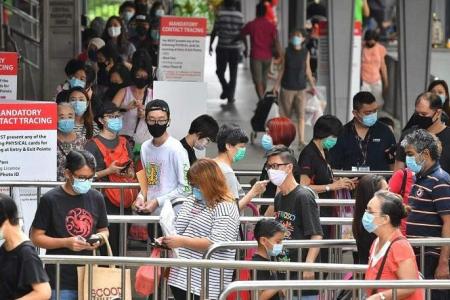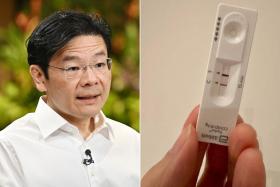Singapore to do away with colour-coded Dorscon framework
Singapore is set to do away with the colour-coded Disease Outbreak Response System Condition (Dorscon) framework in favour of a more intuitive system of informing the masses about the public health situation.
Health Minister Ong Ye Kung announced in Parliament that the Infectious Diseases Act (IDA), the principal legislation for the prevention and control of infectious diseases, will be amended to reflect four public health situational tiers.
The first tier is the baseline state, which reflects a peacetime state, he said in his speech during the debate on the white paper on Singapore’s response to Covid-19.
The second tier is outbreak management - where a pathogen of concern is detected and measures may need to be implemented urgently to manage disease outbreaks. These include contact tracing and quarantine, testing, border controls, and masking, which will buy time for Singapore to understand the pathogen’s characteristics.
The third tier is the public health threat - where more stringent, widespread and longer-term control measures and restrictions are needed. These include various safe management measures and restrictions, up to and including a circuit-breaker like imposition.
The final and most serious tier is the public health emergency. This is where very stringent measures such as curfews and requisition of public health assets and manpower may be effected.
The 92-page report analysing Singapore’s response to the pandemic had pointed out that the Government had decided to be transparent and announce the Dorscon level publicly, even though it had been intended as a tool for ministries and agencies to coordinate a response.
But that move had caused some panic. There was therefore a need to design and communicate indicators of crisis severity and related public health measures to avoid causing undue public anxiety, the white paper had said.
In laying out the changes to the legislation, Mr Ong said that as opposed to colours, it is more intuitive to tell the public that there is an outbreak, threat or emergency, and that the law would also spell out what measures would take place under each state.
“Will this therefore prevent the panic buying that we saw during Covid-19 when we changed Dorscon to yellow and orange? Indeed, not on its own. If we just change colour to descriptors, there’s no reason why panic will just disappear,” he said.
“Whether people panic during a crisis depends a lot on the information they are getting, and whether they know what to do, to protect themselves and contribute towards societal resilience. If people listen to rumours, do not know what to do, they are likely to rush to the supermarkets and stock up on toilet paper and instant noodles.”
Mr Ong also explained that there is a need to update the IDA because it envisages only two worlds of public health - peacetime or emergency, with no gradations in between. While the IDA empowers the health minister to declare a public health emergency, activating extensive powers such as controlling the movements and gatherings of people and imposing curfews had not ben needed.
“While Covid-19 was a crisis and a serious threat, we did not declare a public health emergency. We wanted to restrict group sizes, but not to control movements of people. We were not planning to impose curfews nor invoke the Requisition of Resources Act to marshal resources,” said Mr Ong.
“In other words, the emergency powers under the IDA were too blunt and heavy compared to the public health measures and safe management measures that were needed at that time,” said Mr Ong, adding that Parliament enacted Part 7 of the Covd-19 (Temporary Measures) Act to provide Singapore with temporary, complementary powers to the IDA.
“Covid-19 taught us that in a prolonged pandemic, we can go through different phases. So the IDA must be amended to deal with a wider range of scenarios. It needs to be more future proof.”
Mr Ong added that once the amendments to the IDA are enacted, the Government intends to rescind Part 7 of the Covd-19 (Temporary Measures) Act.
Get The New Paper on your phone with the free TNP app. Download from the Apple App Store or Google Play Store now


